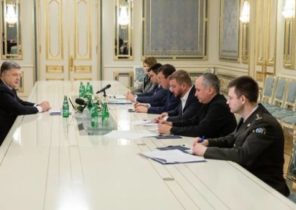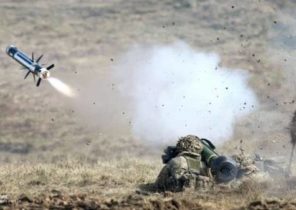
In 2009, the U.S. Navy began construction of the first 35 years of the carrier of the new type. Named after former U.S. President and naval Aviator Gerald Ford, the ship fully became a nuclear aircraft carrier of the 21st century. Applied in a new vehicle technological innovation led to unavoidable delay in the construction of the first aircraft carrier; but these innovations will help the U.S. Navy in the foreseeable future to become the owner of a unique fleet of supereminence, which are the largest and most modern in the world.
Ford followed in the footsteps of the hugely successful American aircraft carriers type “Nimitz”. Its construction began in 2009 in the shipyards of the company Huntington Ingalls Industries in Newport news, Virginia, where he created the carriers of the precursor. I must say that “Ford” is very similar to the “Nimitz”. With a length of 337 meters, while the “Nimitz” it is equal to 333 meters. Displacement of both carriers is the same, making a total load of 100 000 tonnes. The scheme of placement of components is also similar. The superstructure on the upper deck of the carriers is on the starboard side. In addition, they have four catapults and angled flight deck.
The new ship is driven by two nuclear reactors AB1 new design. They are made by the Bechtel company, which surpassed its long-standing and strong competitors General Electric and Westinghouse received an order for construction of the power plant. Collectively, the two reactors generate 600 megawatts of electricity, that is, three times more than the “Nimitz”, with its 200 megawatts. This electricity is enough to power all the homes in HAMPTON, Virginia, Pasadena, California, or Syracuse, new York.
Ford needs all this electricity, not only for the development of the maximal speed of 35 knots, but also to power the new electromagnetic catapult EMALS based on the linear electric motor, where electric current creates a powerful magnetic field that gives the plane the necessary acceleration to reach takeoff speed. About this system is said to be easier that it extends aircraft life, that it is easier to maintain, and that it is able to provide 25% more sorties than the old steam catapult.
The new carrier will also be used more modern system of landing aircraft. The new turbo-electric arrestor the company General Atomics the tension of the cable will be regulated by the induction motor, which will provide a smoother run. As electromagnetic catapults, the arresting gear should be more reliable than the current “Nimitz” braking device. It will also relieve the stress on the airframe.
The aircraft carrier “Ford” the most modern in the fleet radar. There is a dual-band radar system, which integrates a multifunction radar AN/SPY-3 Aegis X-band radar volumetric review of VSR S-band. This dual-band radar system provides search, tracking and illumination of a large number of targets for missiles, the detection of aircraft and missiles and launch interceptor missiles Evolved Sea Sparrow Missile (ESSM) to destroy them.
For self-defense on the aircraft carrier there are two launchers Mk. 29 eight ESSM missiles each, and two launchers for anti-aircraft missiles RAM. The ship is also equipped with a system of melee weapons Phalanx for facility defense against aircraft, missiles and small enemy ships, and four M2 machine guns caliber.50. Huge electric power will allow Ford to run to place on the Board of a defensive laser weapons. Such a weapon, receiving energy from the ship’s reactors will have virtually unlimited ammunition, which will significantly enhance the defensive capabilities of an aircraft carrier.
Wing aircraft carrier-based aircraft is the main offensive and defensive weapons, “Ford.” On Board the aircraft carrier will host two squadrons of a single strike fighter F-35C for 10-12 cars, two squadrons of fighter-attack aircraft F/A-18E/F Super Hornet 10-12 aircraft, five aircraft electronic warfare EA-18G Growler, four AWACS aircraft E-2D Hawkeye and two transport aircraft C-2 Greyhound. Part of the wing will also include eight helicopters MH-60S Seahawk. Later the ship will have to adopt drones for refueling and reconnaissance MQ-25 Stingray. Over time, the sixth generation fighter to replace Super Hornet, but if Senator John McCain will insist on his own, aboard “the Ford” will be a new assault unmanned aerial vehicles long range. And the tiltrotor V-22 Osprey can replace the C-2 Greyhound as a cargo aircraft.
When the “Ford” will enter into fighting structure of fleet, number of aircraft carriers in the Navy has again increased to 11. Carrier battle group Navy is unique in that Congress legally established minimum number. In section 5062 of the code of laws of the United States reads: “the Combat forces of the Navy should include not less than 11 active aircraft carriers”. While in the Navy this requirement is not met.
There will be other carriers of the new type. “John Kennedy” will be the second ship in this series, receiving the name of the 35th President of the United States. Currently, it is being built in Newport news and the Navy he will enter in 2020. Bookmark the third carrier enterprise is expected next year and in operation it will be included in the early-2020s. In the framework of the efforts of President Donald trump and the chief of the naval staff to increase the number of vehicles up to 350-355 units in the near future can be laid at least one more aircraft carrier type “Ford”.
Although this ship is equipped with the latest technology, their problems he also. Serious difficulties arose in the development of electromagnetic catapult EMALS and the new arresting gear, and in the Navy for some time even thought about how to put on a “Kennedy” more traditional and reliable brake system. Despite the difficulties in the design process, the new system take-off and landing is almost ready. According to the Navy, “Ford” is built on 99% and testing was completed by 93%. The combat strength of the Navy aircraft carrier need to sign in April.
Kyle Mizokami is a specialist in the field of defense and national security. Lives and works in San Francisco, and his articles are published in such publications as the Diplomat, Foreign Policy, War is Boring and the Daily Beast. In 2009, he became one of the founders of the blog Japan Security Watch.







